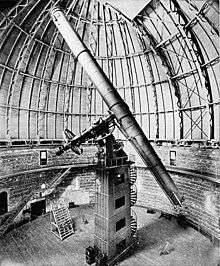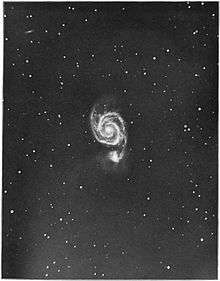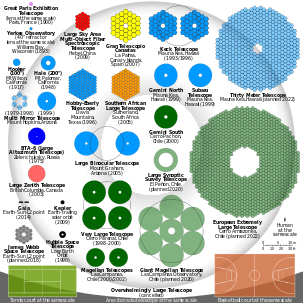Yerkes Observatory
 | |||||||||||
| Organization | University of Chicago | ||||||||||
|---|---|---|---|---|---|---|---|---|---|---|---|
| Code | 754 | ||||||||||
| Location | Williams Bay, United States of America | ||||||||||
| Coordinates | 42°34′13″N 88°33′22″W / 42.570277777778°N 88.556111111111°WCoordinates: 42°34′13″N 88°33′22″W / 42.570277777778°N 88.556111111111°W | ||||||||||
| Altitude | 334 m (1,096 ft) | ||||||||||
| Website |
astro | ||||||||||
| Telescopes | |||||||||||
| |||||||||||
|
| |||||||||||



Yerkes Observatory is an astronomical observatory in Williams Bay, Wisconsin operated by the University of Chicago Department of Astronomy and Astrophysics. [1][2] The observatory, which calls itself "the birthplace of modern astrophysics,"[3] was founded in 1897 by astronomer George Ellery Hale and financed by businessman Charles T. Yerkes.[4] It represented a shift in the thinking about observatories, from their being mere housing for telescopes and observers, to the modern concept of observation equipment integrated with laboratory space for physics and chemistry.
The observatory has the world's largest refracting telescope successfully used for astronomy[5] and a collection of over 170,000 photographic plates.[6] The director of the observatory is Doyle "Al" Harper.[7] Notable astronomers who have conducted research at Yerkes include Edwin Hubble (who did his graduate work at Yerkes and for whom the Hubble Space Telescope was named), Subrahmanyan Chandrasekhar (for whom the Chandra Space Telescope was named), prolific Russian-American astronomer Otto Struve,[8] and the twentieth-century popularizer of astronomy Carl Sagan.
Telescopes

Yerkes Observatory's 100 cm (40 in) refracting telescope was built by the refracting telescope company Alvan Clark & Sons. It is the largest refracting telescope used for scientific research.[9] (A larger demonstration refractor, the Great Paris Exhibition Telescope of 1900, was exhibited at the Paris Universal Exhibition of 1900.) The mounting and tube for the 100-centimeter (40 in) telescope was exhibited at the 1893 World's Columbian Exposition in Chicago before being installed in the observatory. The grinding of the lens was completed later.[10]
The observatory also houses 100 cm (40 in) and 61 cm (24 in) reflecting telescopes. Several smaller telescopes are used for educational purposes.
Research
Research conducted at Yerkes includes work on the interstellar medium, globular cluster formation, infrared astronomy, and near-Earth objects. The University of Chicago also maintains an engineering center in the observatory, dedicated to making and maintaining scientific instruments. In 2012 the engineers completed work on the High-resolution Airborne Wideband Camera (HAWC), which will be an integral part of the Stratospheric Observatory for Infrared Astronomy (SOFIA).[11] Researchers also use the Yerkes collection of over 170,000 archival photographic plates that date back to the 1890s.[12]
Development and preservation plans
In March 2005, the University of Chicago announced plans to sell the observatory and its land on the shore of Geneva Lake. Two purchasers had expressed an interest: Mirbeau, an East Coast developer that wanted to build luxury homes, and Aurora University, which has a campus straddling the Williams Bay property. The Geneva Lake Conservancy, a regional conservation and land trust organization, maintained that it was critical to save the historic Yerkes Observatory structures and telescopes for education and research, as well as to conserve the rare undeveloped, wooded lakefront and deep forest sections of the 310,000-square-meter (77-acre) site. On June 7, 2006, the University announced it would sell the facility to Mirbeau for US$8 million with stipulations to preserve the observatory, the surrounding 120,000 m2 (30 acres), and the entire shoreline of the site.[13] Under the Mirbeau plan, a 100-room resort with a large spa operation and attendant parking and support facilities was to be located on the 36,000-square-meter (9-acre) virgin wooded Yerkes land on the lakeshore—the last such undeveloped, natural site on Geneva Lake's 34-kilometer (21-mile) shoreline. About 70 homes were to be developed on the upper Yerkes property surrounding the historic observatory. These grounds had been designed more than 100 years previously by John Olmsted, the brother of famed landscape architect Frederick Law Olmsted, designer of New York's Central Park. Ultimately, Williams Bay's refusal to change the zoning from education to residential caused Mirbeau to abandon its development plans.
In view of the public controversy surrounding the development proposals, the university suspended these plans in January 2007.[14] The university's department of astronomy and astrophysics then formed a study group, including representatives from the faculty and observatory and a wide range of other involved parties, to plan for the operation of a regional center for science education at the observatory.[15] The study group began its work in February 2007 and issued its final report November 30, 2007.[16] The report recommended creating a formal business plan to ensure the financial viability of the proposed science education center, establishing ownership of the proposed center before initiating plans for creating it, and forming a partnership between the University of Chicago and local interests to plan for the center. It also suggested that some lakefront and woods parcels could be sold for residential development.[16]
See also
References
- ↑ Yerkes Observatory-Home
- ↑ The Department of Astronomy and Astrophysics at the University of Chicago-A Bit of History
- ↑ Observatory website
- ↑ Yerkes Observatory - 1892-1893 History of Yerkes Observatory
- ↑ Elizabeth Howell (August 15, 2014). "Yerkes Observatory: Home of Largest Refracting Telescope". Space.com. Retrieved December 15, 2015.
- ↑ Observatory website
- ↑ The Department of Astronomy and Astrophysics at the University of Chicago-Doyle "Al" Harper
- ↑ The Department of Astronomy and Astrophysics at the University of Chicago-A Bit of History
- ↑ Starr, Frederick (October 1897). "Science at the University of Chicago". Popular Science Monthly. New York: D. Appleton and Company. 51 (May to October 1897): 802–803. Retrieved October 25, 2015.
- ↑ Yerkes Observatory - 1893 History of Yerkes Observatory
- ↑ Yerkes Obervatory-R & D-HAWC
- ↑ The Yerkes Obervatory Photographic Plates
- ↑ The agreement provided for preservation of historic Yerkes Observatory
- ↑ Topic Galleries - chicagotribune.com
- ↑ Yerkes Study Group formed to consider observatory's future
- 1 2 Final Report of the Yerkes Study Group, November 30, 2007, Yerkes Science Center: Optionsw for Management and Funding
External links
![]() Media related to Yerkes Observatory at Wikimedia Commons
Media related to Yerkes Observatory at Wikimedia Commons
- Yerkes Observatory (official site).
- Description and history from the National Park Service.
- Save Yerkes
- Yerkes Study Group
- Geneva Lake Conservancy